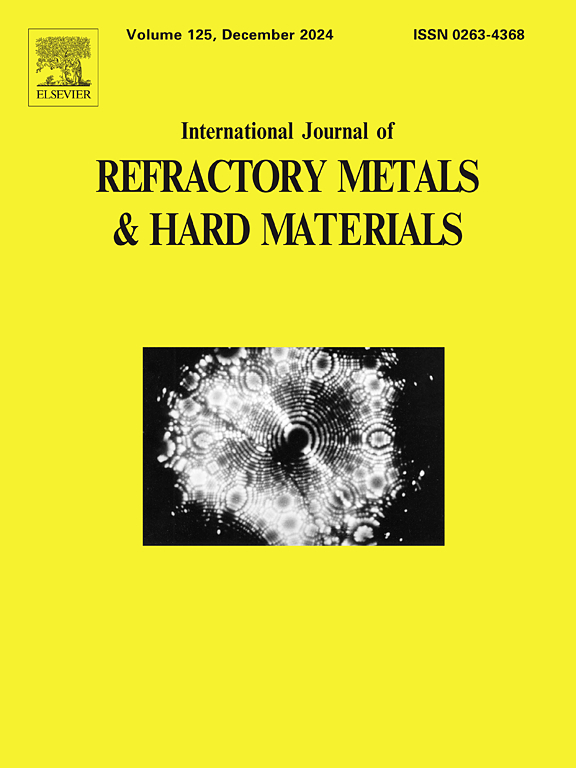Effect of interlayers on thermal residual stresses in diamond/MPEA composites predicted by finite element method
IF 4.2
2区 材料科学
Q2 MATERIALS SCIENCE, MULTIDISCIPLINARY
International Journal of Refractory Metals & Hard Materials
Pub Date : 2025-02-01
DOI:10.1016/j.ijrmhm.2025.107080
引用次数: 0
Abstract
The thermal residual stresses in diamond/MPEA (multi-principal element alloy) composites with various interlayers were analyzed using finite element method by both macro- and micro-models. Firstly, we investigated the temperature evolution in the composites during the cooling stage of the spark plasma sintering process. Then, the effects of interlayers introduced between the diamond and MPEA on the evolution and distribution of thermal residual stresses within the composites were studied. The simulation results demonstrate that incorporating a metal interlayer can effectively reduce thermal residual stress and elastic strain in the composites through plastic deformation, particularly when utilizing a metal interlayer with reduced yield strength. Comparatively, a carbide interlayer induces a high-level thermal residual stress primarily located in the carbide interlayer itself and the proximate contacting areas in diamond and the binder phase. Particularly, this stress will not decrease the mechanical properties of the composites, since it has a tensile first principal stress parallel to the interfaces formed between the carbide interlayer and metal interlayer, as well as the carbide interlayer and diamond, and a compressive third principal stress perpendicular to those interfaces. Consequently, the diamond composites with both a metal interlayer and a carbide interlayer are expected to exhibit lower levels of residual stress, which protect diamond particles from graphitization, thereby resulting in superior mechanical performance.
用有限元法预测夹层对金刚石/MPEA复合材料热残余应力的影响
采用有限元方法对含不同夹层的金刚石/MPEA(多主元素合金)复合材料的热残余应力进行了宏观和微观分析。首先,我们研究了复合材料在放电等离子烧结冷却阶段的温度演变。然后,研究了金刚石与MPEA之间引入的夹层对复合材料内部热残余应力演化和分布的影响。仿真结果表明,在复合材料中加入金属中间层可以有效地通过塑性变形降低复合材料中的热残余应力和弹性应变,特别是在使用屈服强度降低的金属中间层时。相比之下,碳化物中间层产生的高残余热应力主要位于碳化物中间层本身以及金刚石和粘结剂相的接近接触区域。特别是,这种应力不会降低复合材料的力学性能,因为它具有平行于碳化物夹层与金属夹层之间以及碳化物夹层与金刚石之间形成的界面的拉伸第一主应力,以及垂直于这些界面的压缩第三主应力。因此,具有金属中间层和碳化物中间层的金刚石复合材料有望表现出较低的残余应力水平,从而保护金刚石颗粒免受石墨化,从而产生优越的机械性能。
本文章由计算机程序翻译,如有差异,请以英文原文为准。
求助全文
约1分钟内获得全文
求助全文
来源期刊
CiteScore
7.00
自引率
13.90%
发文量
236
审稿时长
35 days
期刊介绍:
The International Journal of Refractory Metals and Hard Materials (IJRMHM) publishes original research articles concerned with all aspects of refractory metals and hard materials. Refractory metals are defined as metals with melting points higher than 1800 °C. These are tungsten, molybdenum, chromium, tantalum, niobium, hafnium, and rhenium, as well as many compounds and alloys based thereupon. Hard materials that are included in the scope of this journal are defined as materials with hardness values higher than 1000 kg/mm2, primarily intended for applications as manufacturing tools or wear resistant components in mechanical systems. Thus they encompass carbides, nitrides and borides of metals, and related compounds. A special focus of this journal is put on the family of hardmetals, which is also known as cemented tungsten carbide, and cermets which are based on titanium carbide and carbonitrides with or without a metal binder. Ceramics and superhard materials including diamond and cubic boron nitride may also be accepted provided the subject material is presented as hard materials as defined above.

 求助内容:
求助内容: 应助结果提醒方式:
应助结果提醒方式:


